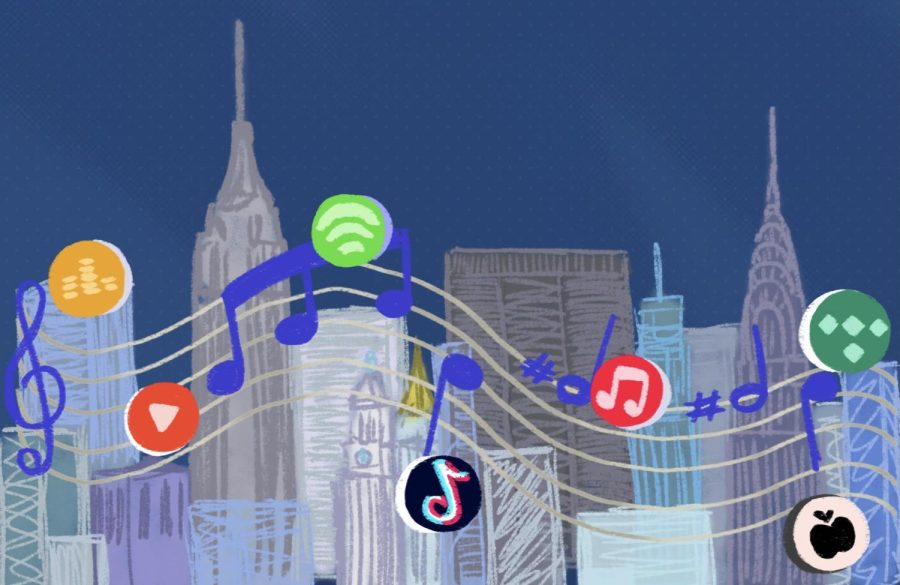Changing technology allows for new distribution means in music industry
April 29, 2022
The music industry is constantly changing as the technology used to distribute and consume it evolves with it. The last decade has seen major shifts in how people get their music, with streaming and digital downloads becoming the standard for billions of listeners around the world. Record labels have taken notice and embraced this change.
Deals have been made between labels and streaming services for exclusivity, including streaming rights. With the rise of social media platforms like TikTok as a way to share music, artists want more autonomy over their music and blockchain technology.
“Old Town Road” by Lil Nas X came to be the United States’ highest certified song after going viral on TikTok, so much so that the rapper credits the app for the song’s success.
“I should maybe be paying TikTok,” the rapper told TIME magazine. “They really boosted the song. It was getting to the point that it was almost stagnant. When TikTok hit it, almost everyday since that, the streams have been up. I credit them a lot.”
This is just one instance of a song becoming popular through TikTok. The social media platform itself has noticed its increasing importance in music distribution, thus partnering with music distribution platform SoundOn in March.
The partnership promised to help small artists find their fanbase and give them more autonomy over their music. SoundOn offers artists 100% of their royalties within the first year and 90% after that. The move departs from the standard artist-record label relationship where newly signed artists usually receive less than 20% of their royalties.
New artists are not the only ones taking advantage of changing trends. Rapper Jay-Z launched the artist-led music streaming platform Tidal in 2015.
The platform had early success due to its exclusive rights to release major songs like singer Beyonce’s “Lemonade” and rapper Kanye West’s “The Life of Pablo,” but the platform was not viable long term, reportedly losing almost $37 million in 2018. The company also lost over 100,000 subscribers.
Square later acquired Jay-Z’s majority stake in the company for $297 million. Despite Tidal’s failure, this has not stopped veteran artists from pursuing musical autonomy.
Ye, who invested in Tidal, had a public feud with former record label Universal Music Group over the release of his 10th studio album “Donda,” resulting in the end of his 17-year deal with the label. The album earned accolades in 2021, becoming Apple Music’s most streamed album in over 152 countries and Spotify’s second biggest album debut.
When he released his next album “Donda 2,” Ye decided to release it exclusively on his “Stemplayer,” a blockchain-powered device that allows listeners to download, stream and adjust and remake musical stems such as vocals and instrumentals. “Donda 2” grossed over $2.2 million in sales the day following the exclusivity announcement.
Aside from stem player blockchain technology like non-fungible tokens, or NFTs, are seeing more widespread adoption among artists. Kings of Leon became the first band to release their album “When You See Yourself” as an NFT with exclusive content in 2021. This distribution method proved to be a success as the NFT generated over $2 million in sales.
Nas partnered with blockchain platform Royal.io to release a royalty-sharing NFT collection featuring songs from his Grammy Award-winning album “Kings Disease” and his Grammy Award-nominated album “Kings Disease II.”
NFTs give owners streaming royalty ownership over select songs along with other perks. This partnership grossed over $560,000 in revenue and sold out within minutes.
Only 78% of music released on Spotify was distributed by record labels in 2020, down from the 87% in 2017. With blockchain platforms and services promising decentralization and how accessible social media has become, record labels are slowly becoming a less viable option as a middle man to market and distribute artists’ music. It is becoming easier for new and veteran artists to market and distribute music, giving them hope in making big financial gains.









Manisha • May 5, 2022 at 9:14 pm
Very insightful!
Militza • Apr 29, 2022 at 6:40 pm
This is the best article ever
Nico • Apr 29, 2022 at 6:24 pm
Greatest article ever